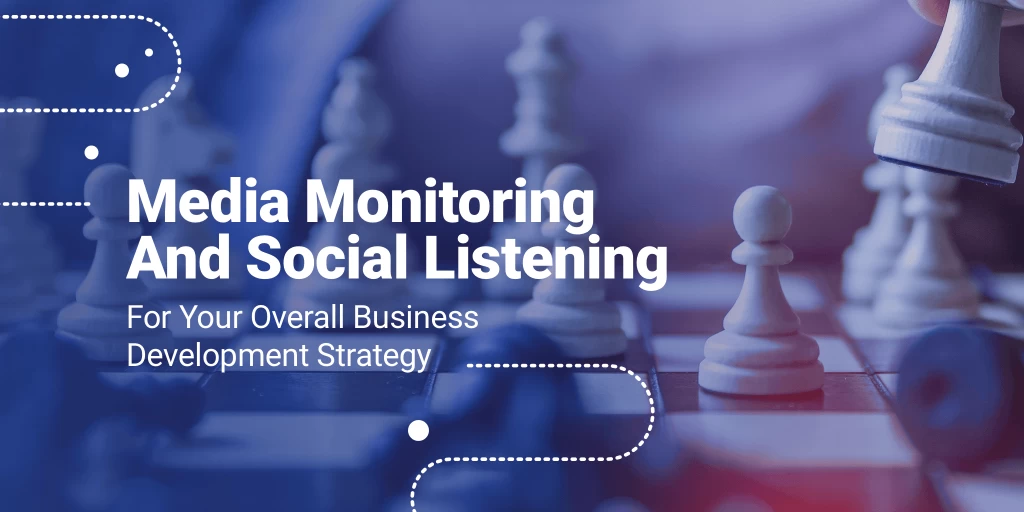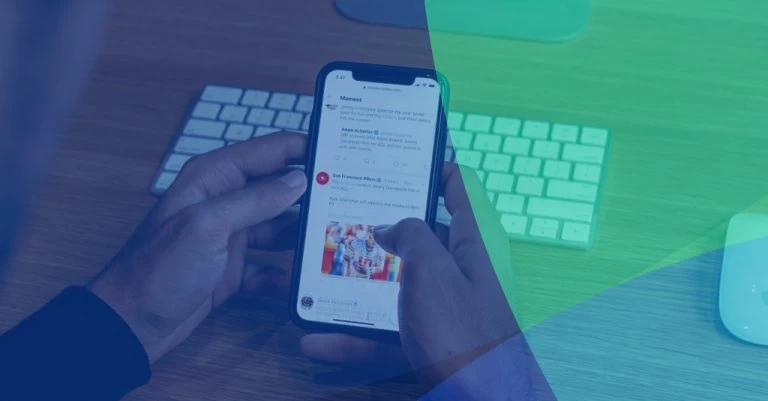Media Monitoring And Social Listening For Your Overall Business Development Strategy

You can’t develop a business without paying attention to the media landscape – now more than ever people are engaged with the companies they patronize and there’s a lot more scrutiny as well as chatter online.
If it’s not on the Internet, it might as well not exist, but if it’s on the Internet – especially if it’s in a negative light – then it’s there forever and ever. Without a watchful eye on what people say about you as a brand and the tools to control the conversation, you can’t develop an effective business strategy for long-term growth.
That’s why every company should perform social listening. According to some, you should extend your listening to full blown media monitoring even. But what do these terms mean and where do we draw the distinction between the two?
The answers to these questions help brands better understand their own needs and allocate budgets accordingly to get the best return on investment.
Media monitoring vs Social listening
You might have seen these terms used interchangeably, but media monitoring and social listening are two very different marketing processes. It’s just there’s a lot of media to collect, go through and then analyze, so there’s bound to be more than techniques to do.
Don’t get us started on how confusing social media monitoring makes the whole equation. So how are media monitoring and social listening related? What are their differences and ultimately what makes them so complementary to each other?
The differences in the concepts
There’s a good reason why we shouldn’t mix up media monitoring and social listening. For one, one has existed for a lot, lot longer. Media monitoring has existed the moment the newspaper made its way to the masses in all social and economic classes. As early as the first company ads in the paper – well maybe a little later than that.
Media monitoring back then consisted of going through all the printed media of the day and cutting out articles, mentioning your brand. Once collected, they’d be arranged into the so-called physical clipbooks. Radio and television had similar journeys in terms of monitoring. Today you’ll notice that certain services like OneNote emulate the functionality of those clipbooks in the way users are able to save articles of note digitally.
Social listening came about the advent of Facebook and Twitter. In the early days, not many people realized how essential social media would be to the wellbeing of brands and their bottom line, but now every company listens to what their customers are saying to and about them. Or at least they should be doing that.
What blurs the lines a little bit is the overlap between media today. Newspapers have migrated online – some as permanent digital editions. You have podcasts that behave as radio and YouTube fills in the same function as television. That tends to lead people to mix up both of them.
How does media monitoring and social listening complement each other?
Social listening fits nearly under the umbrella processes associated with media monitoring so they have a lot more in common than they don’t. It’s just that media monitoring extends its hand beyond the limits of social media and online spaces to gauging public and corporate sentiment towards a brand.
In that sense, both concern themselves with conversation. Social listening tunes its ear to the end consumer and any expert figures on the Internet and is considerably data driven. You can use the capabilities of social listening tools to break down your target audience into demographics and any online campaign into performance statistics. This information later feeds into the betterment of a brand’s approach to their target audience.
Media monitoring takes into account how the brand is perceived on a higher level – What are the leaders in the industry saying? Is the mainstream news or trade publications aware of the brand? If so, in what way? Social media and the erosion of distance between company and consumer have tied these two realms together. What happens on social media platforms easily echoes in traditional media, so it makes sense to have both media monitoring and social listening working in tandem.
How to use them for your overall business development?
It should be noted that both media monitoring and social listening bear fruits of your labor after a little bit of time. It’s a marathon and not a sprint, so you should look at both processes as a long-term investment rather than a quick return on investment. For that you should turn to social media monitoring, which focuses on the here and now happening in your social media accounts.
Because they’re slower to deliver insights and overview of trends, both processes can be seen as higher level strategies. They help you steer the ship so to speak. Done right you’ll have enough foresight to avoid scandals, tone-deaf messaging, PR disasters, moral obsolescence and losing the grip over your customers. No person stays the same. This applies to consumer behavior. Whether your product remains the same consistent level of quality doesn’t matter as long as it doesn’t align with customer values, preferences and tastes.
The results of media monitoring and social listening give you a head’s up on such big changes in taste, buyer persona, the preferred spaces of your customers and where the industry is headed. The biggest perhaps benefits of doing these forms of monitoring lies in understanding where you find yourself as a brand in a larger context:
The significance of media trends
As long as civilization has existed people have placed values in communication and have tried to reach as many people as possible with their message. Media consumption and media evolution over the last century has shown how eager people are to get connected between each other and since selling is all about being in conversation with your audience it’s essential to pop up where your target audience hangs out.
Media monitoring and investigation into consumer online habits ensures that you’re where you need to be to reach your target audience. A key characteristic – and a great risk to many companies – of the Internet is that you have to be present and visible or otherwise you’ll fall into obscurity. Those brands who’ve failed to identify new media formats and channels to transition to are often the very first to register a steady decline in sales numbers.
Obsolescence looms large as the Internet kicks up the pace. Online communities and media rise and fall at greater speed, and it’s a brand’s task to strike that fine balance between the established institutions of media such as print and television and the new often in the form of social media.
The importance of media for your strategic decisions
We’re going to go back to the metaphor about conversations. You know where your audience has conversations among themselves and occasionally about your brand; certainly about the products you can offer them. You know what language they use. You know their values and needs in great detail – social listening when done right cracks open the mind of your target customer and gives you spectacular insights.
Now… the last question is how to continue existing conversations and start new ones. The data you’ve extracted from media monitoring and social listening presents several key points:
- State of the industry and relation to competitors
- State of your customers and their preferred communication styles
- Insight into the type of content that receives high engagement levels.
That’s enough of a foundation to move ahead with targeting better marketing campaigns, which not only engage with your audience in a meaningful way, but receive good feedback from industry press and players in your market. Through careful calibration brands can boost sales numbers and improve their image at the same time.
Optics matter! Therefore, brands should always be in step with public opinion and be flexible in changing course to keep their reputation intact.
How to do media monitoring?
As with all type of marketing research, media monitoring requires you know the following:
What are you monitoring for? These are the reasons why you even bother. Perhaps it’s the best way to see whether or not your new product has caused waves, or it could be as simple as investigating trade press following the wake of breaking news surrounding a competitor and how that can translate into a pocket of opportunity.
What are you monitoring with? Keywords and key phrases. How do your customers search about you and your products or the product and service types in your industry? How do they ask for recommendations and what are top features of great importance?
Where are you monitoring? The places you’re going to target. Social media falls under this umbrella process – we’ll touch upon that last – but it’s those other types of traditional media you want to explore predominantly.
How are you doing the monitoring? This is where you decide on the tool that does the job best. Some social media listening tools branch out outside social media platforms, but you also need a tool able to scour all media types, going far and wide to get the job done. Agility PR is perhaps one of the best on the market and offers you everything above and more.
How to do social listening?
Social listening follows the same basic tenets as media monitoring. The chief difference lies in the specialization of the data gathering and analysis. Typically, social listening applies to most online spaces with some tools like Talkwalker able to target forums, review sites and blogs as well thus stepping into media monitoring territory.
However, the star of the show is always social media – Twitter most often, though you’ll see tools have the capacity to analyze data from Facebook and Instagram and YouTube. It’s imperative to catch all conversations and interaction on account level to manage your relationship with your brand. You’re also getting insights on your performance directly from your customers, which is essential to improve on customer care.
You want tools like Hootsuite, which can perform excellent social monitoring of your accounts to manage your brand presence, and Sprout Social, which opens up the search to insights beyond any direct mentions. If you’re interested in specific mentions in specific hashtags or publications, then you can easily step up Google Alerts and Inoreader to capture those mentions. Inoreader also has fantastic native search, which can be customized in a variety of ways to achieve the same, if not better, monitoring results.


